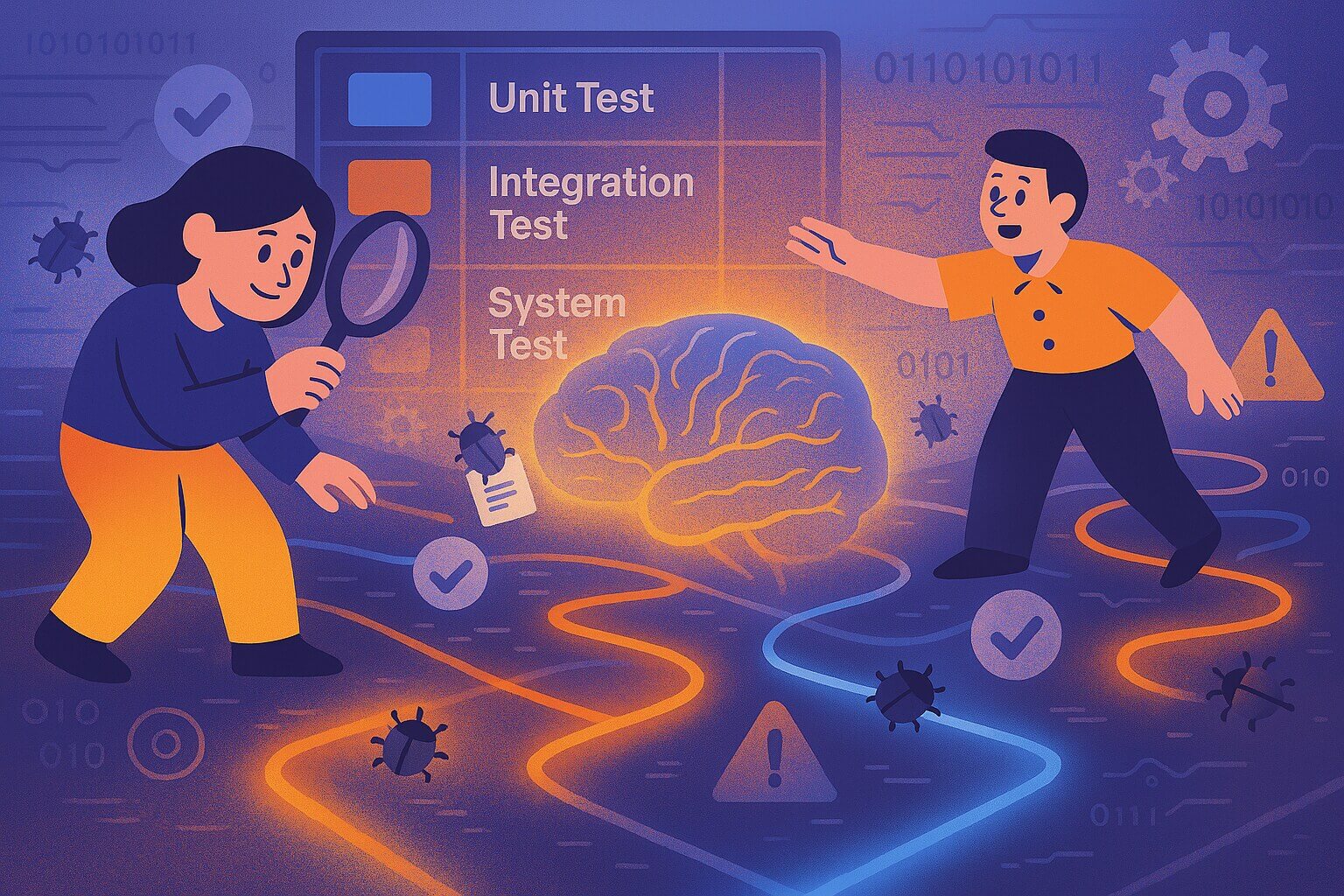Whether you’re a testing veteran or just getting your feet wet, having the right testing strategies can be the difference between shipping with confidence and that 3 AM “everything is on fire” call.
In this guide, we’re breaking down everything you need to know about testing strategies in software engineering—no fluff, just practical insights you can actually use in your next sprint.
Understanding Software Testing and Its Importance
You know that feeling when you push code to production and immediately start sweating? That’s your body’s natural reaction to insufficient testing. Good testing is like having insurance—you hope you never need it, but you’re really glad it’s there when things go sideways.
The Real Cost of Poor Testing
History is littered with expensive software failures that could have been prevented with better testing:
- Mars Climate Orbiter: NASA’s $125 million spacecraft crashed into Mars in 1998 because one team used metric units while another used imperial. A simple validation test could have caught this mismatch.
- British Airways System Failure: In 2019, a massive system issue led to hundreds of canceled flights, stranded passengers, and the company switching to manual check-ins. Not a good look.
- Therac-25 Radiation Machine: Perhaps the most sobering example—software errors in this medical device led to patients receiving massive radiation overdoses, causing injuries and deaths.
These are reminders (serious ones) that testing isn’t bureaucratic overhead. It’s a safety net that protects users, your company’s reputation, and sometimes even lives.
For effective software testing practices, you need a test management system (TMS). Aqua cloud, an AI-powered TMS, gives you peace of mind by delivering the ultimate, AI-powered efficiency. With aqua cloud, you can generate test cases, requirements, and test data within 3 clicks, no hussle. With native automation integrations like Selenium, Cypress, Ranorex, you’ll supercharge your efforts. Centralised repository will help you manage all your tests from one platform. The multi-language AI copilot will ensure seamless collaboration between your team members all-around the world.
Supercharge your testing efforts by 42% time and resource saving
The Business Case for Testing
Beyond preventing disasters, solid testing strategies deliver tangible business benefits:
- Lower development costs: Finding bugs early costs way less than fixing them after release
- Faster time to market: Contrary to popular belief, good testing actually speeds up development by reducing rework
- Higher customer satisfaction: Users notice quality, even if they can’t articulate what makes software feel “solid”
- Reduced maintenance headaches: Well-tested code is usually better organized and easier to maintain
Ready to test your testing strategy instincts? Before we dive deeper into each testing approach, let’s see how quickly you can recognize which strategy fits each scenario. The interactive challenge below will sharpen your pattern recognition skills—the same skill that separates good QA leads from great ones. You’ll face 10 real-world bugs and have just 5 seconds each to choose the right testing strategy. Can you reach Master Bug Hunter status?
🎯 Bug Bounty Hunter: Test Your Pattern Recognition (Click to open)
▼⚡ Speed Challenge: Bugs appear for 5 seconds. Match them with the right testing strategy before time runs out!
🎯 Goal: Get the highest score and longest streak. Can you reach Master Bug Hunter rank?
Categories of Software Testing
When planning your testing strategy, it helps to understand the two main categories: functional and non-functional testing. Each answers a fundamental question about your software.
| Testing Type | Key Question | Focus Areas | Common Methods |
|---|---|---|---|
| Functional Testing | “Does it work?” | Feature correctness, Business logic, Integration points | Unit testing, Integration testing, System testing, Acceptance testing |
| Non-Functional Testing | “Does it work well?” | Performance, Security, Usability, Reliability | Load testing, Security testing, Usability testing, Compatibility testing |
Functional Testing
Functional testing is all about verifying that your software does what it’s supposed to do. It checks that each feature works according to specifications and that the system functions correctly as a whole.
Key functional testing types include:
1. Unit Testing: Testing individual components in isolation
# Example of a simple unit test for a login function
def test_valid_login():
result = login(“valid_user”, “correct_password”)
assert result == “Login successful”
2. Integration Testing: Checking how components work together
This might test if your authentication service properly communicates with your user database.
3. System Testing: Evaluating the complete, integrated system
Testing the entire application from end to end to ensure all parts work together.
4. Acceptance Testing: Verifying the software meets business requirements
Often performed by actual users or product owners to ensure the software solves real problems.
5. Regression Testing: Making sure new changes don’t break existing functionality
Running tests after changes to confirm everything still works as expected.
Non-Functional Testing
While functional testing tells you if your software works, non-functional testing tells you if it works well. This has become increasingly critical as user expectations have risen dramatically.
Key non-functional testing types include:
1. Performance Testing: How does your system handle load?
- Load testing (normal conditions)
- Stress testing (extreme conditions)
- Endurance testing (over time)
2. Security Testing: Is your software protected against threats?
- Vulnerability scanning
- Penetration testing
- Security code reviews
3. Usability Testing: Can users actually use your software effectively?
- User experience evaluations
- Accessibility testing
- A/B testing of interfaces
4. Compatibility Testing: Does it work across different environments?
- Browser compatibility
- Device compatibility
- Operating system compatibility
By 2025, non-functional testing will be absolutely essential for organisations looking to deliver high-quality software. Users now expect applications that aren’t just functional but also fast, secure, and intuitive.
Manual vs. Automated Testing
The manual vs. automated testing debate isn’t about which is better—it’s about knowing when to use each approach.
Manual Testing: The Human Touch
Manual testing involves a human tester executing test cases without automated tools. Think of it as the artisanal craft beer of testing—lovingly created by hand.
When to go manual:
- For exploratory testing where you’re discovering issues as you go
- Testing usability and user experience (machines can’t tell if something feels awkward)
- Ad-hoc testing to find unexpected issues
- Short-term projects where automation setup would take longer than the project itself
Manual testing shines when human judgment is needed—evaluating design, finding unexpected issues, or thinking creatively about how to break the system.
Automated Testing: Efficiency at Scale
Automated testing uses tools and scripts to run tests without human intervention. It’s like having a testing robot that never gets tired, bored, or distracted.
When to automate:
- Repetitive tests that run frequently (regression testing)
- Tests requiring precise timing or measurement
- Tests that need to run across multiple configurations
- Performance or load testing (humans can’t simulate thousands of users)
Automation particularly excels with repetitive tasks and scenarios requiring precision and consistency.
Making the Right Choice between Manual and Automated Testing
Here’s a quick decision framework for choosing between manual and automated testing:
| Factor | Choose Manual If… | Choose Automation If… |
|---|---|---|
| Test frequency | Test runs only occasionally | Test runs repeatedly |
| Stability | Requirements change frequently | Requirements are stable |
| Complexity | Test requires human judgment | Test has clear pass/fail criteria |
| Time horizon | Short-term project | Long-term product |
| Resources | Limited technical expertise | Available engineering resources |
Software Testing Strategies
Now that we understand the types of testing, let’s explore specific strategies you can implement in your software engineering process.
Your test strategy defines the levels of testing, who is responsible / accountable / involved in designing and maintaining the tests at each level, how you create and maintain test data, your test environments, and all of the tools you need to support testing.
Static Testing Strategy
Static testing examines code without executing it. Think of it like proofreading your code before actually running it.
Key techniques:
- Code reviews: Having team members review each other’s code
- Static analysis tools: Using automated tools to find potential issues
- Walkthroughs: Explaining your code to others to identify logic flaws
Benefits of static testing:
- Catches issues early in development
- Identifies issues that might be hard to find during execution
- Improves code quality and maintainability
- Can find security vulnerabilities before code is even run
Static testing is increasingly being moved earlier in the development lifecycle as part of a shift-left approach, where testing activities happen as soon as possible in the development process.
Structural Testing Strategy
Structural testing (also called white-box testing) examines the internal workings of your code. It’s like checking not just that your car runs, but looking under the hood to make sure all the parts are connected correctly.
For a general test strategy I'd fall back on a generic statement like this is to prioritize testing based on risk and business value.
Key techniques:
- Statement coverage: Ensuring each line of code executes at least once
- Branch coverage: Testing all possible decision paths
- Path coverage: Testing all possible routes through the code
For example, consider this simple function:
function divideIfPositive(a, b) {
if (a > 0 && b > 0) {
return a / b;
} else {
return "Both numbers must be positive";
}
}
Good structural testing would test:
- Both a and b positive (normal case)
- a negative, b positive (error case)
- a positive, b negative (error case)
- Both a and b negative (error case)
Behavioral Testing Strategy
Behavioral testing (also called black-box testing) focuses on the external behavior of your software from the user’s perspective. It’s less concerned with how the code works internally and more with whether it behaves correctly.
Key techniques:
- Boundary value analysis: Testing at the edges of valid input ranges
- Equivalence partitioning: Dividing inputs into valid and invalid groups
- Decision table testing: Testing combinations of inputs and conditions
- Use case testing: Testing typical user scenarios
For behavioral testing to be effective, consider these best practices:
- Define clear test scenarios: Be specific about what you’re testing and what outcome you expect
- Focus on the user: Think about how real people will interact with your software
- Use behavior-driven language: Write tests in a way that’s understandable by both technical and non-technical team members
- Design for reusability: Create test components that can be reused across different scenarios
Behavioral testing techniques like A/B testing can provide valuable insights into how users interact with your software, helping you make data-driven improvements.
Front-End Testing Strategy
Front-end testing focuses specifically on the user interface and user experience. It ensures that what users see and interact with works as expected.
Key techniques:
- UI testing: Verifying that UI elements appear and function correctly
- Visual regression testing: Ensuring UI changes don’t break the design
- Cross-browser testing: Verifying that the UI works across different browsers
- Accessibility testing: Ensuring the UI is usable by people with disabilities
Front-end testing often combines manual and automated approaches. While automation can verify that elements exist and function correctly, human judgment is still valuable for evaluating design and user experience.
Selecting the Right Testing Strategy
With so many testing approaches available, how do you choose the right one for your project? Here’s a practical framework to help you decide.
Assessment Factors for Testing Strategy Selection
Your testing strategy should be tailored to your specific project needs based on these key factors:
1. Project characteristics
- Size and complexity
- Timeline and budget constraints
- Criticality (is this a life-critical system or a marketing landing page?)
2. Team capabilities
- Technical expertise
- Experience with different testing methods
- Available resources
3. Risk assessment
- Potential impact of failures
- Security requirements
- Regulatory compliance needs
Decision Framework
Here’s a simplified decision tree to help you select appropriate testing strategies:
For small projects with tight deadlines:
- Focus on manual testing
- Prioritise critical user paths
- Consider lightweight automated smoke tests
For large, complex applications:
- Implement comprehensive automated testing
- Layer different testing strategies (unit, integration, system)
- Consider CI/CD integration for continuous testing
For high-security applications:
- Prioritise security testing
- Implement static code analysis
- Consider penetration testing
For consumer-facing applications:
- Emphasize usability and UI testing
- Implement cross-browser and cross-device testing
- Consider A/B testing for key features
Strategy Selection Checklist
Use this checklist when selecting your testing strategy:
- [ ] Have we identified the most critical functionality to test?
- [ ] Do we understand our users and their expectations?
- [ ] Have we assessed the risks associated with potential failures?
- [ ] Does our team have the skills to implement this strategy?
- [ ] Is our strategy aligned with our development methodology (Agile, DevOps, etc.)?
- [ ] Have we balanced manual and automated approaches appropriately?
- [ ] Does our strategy account for both functional and non-functional requirements?
Remember that marketing data insights can help prioritise which scenarios to test by identifying the most common user paths and popular browsers/devices.
Integrating Testing Strategies Throughout the Software Development Lifecycle
The most effective testing approaches are integrated throughout the entire software development lifecycle, not tacked on at the end.
Early SDLC Phases
Requirements Phase:
- Review requirements for testability
- Identify acceptance criteria
- Begin planning test strategy
Design Phase:
- Involve testers in design reviews
- Ensure designs support testability
- Begin creating test cases based on design
Middle SDLC Phases
Implementation Phase:
- Implement unit tests alongside code
- Perform code reviews (static testing)
- Begin integration testing as components are completed
Testing Phase:
- Execute planned test cases
- Perform system and acceptance testing
- Conduct specialized testing (security, performance, etc.)
Late SDLC Phases
Deployment Phase:
- Run smoke tests in production environment
- Monitor for issues during rollout
- Prepare for post-release testing
Maintenance Phase:
- Run regression tests for updates
- Continue monitoring performance
- Update test cases as features evolve
Tools Integration
Successfully integrating multiple testing tools requires a structured approach:
1. Identify testing requirements: Determine what types of tests you need, how often they should run, and what level of automation is appropriate
2. Select the modern, AI-powered and reliable tools: Choose tools that match your requirements and integrate well with your development environment.
Because to master software testing, you need more than spreadsheets and scattered tools — you need a powerhouse like aqua cloud, the AI-fueled Test Management System built for speed, precision, and scale. In just 3 clicks, you can instantly generate test cases, requirements, and test data — no friction, no delays. Plug into native automation tools like Selenium, Cypress, and Ranorex to launch faster, test smarter, and eliminate bottlenecks. Manage everything from a centralised command center, keeping your entire testing lifecycle aligned and under control. With aqua, you get 100% traceability, test coverage, and visibility – giving you full control of your test management.
Let AI handle 98% of the manual work for you
3. Integrate tools into your workflow: Set up your CI/CD pipeline to automatically run tests at appropriate stages
4. Execute and analyse: Run tests, analyse results, and address any issues that arise
This integrated approach ensures comprehensive quality assurance throughout the software development process.
Conclusion
Testing is the safety net that lets your team move fast without breaking things (or at least without breaking important things). By implementing thoughtful testing strategies in your software engineering process, you’re not just finding bugs—you’re building confidence in your code.
Remember these key takeaways:
- Different testing types serve different purposes—use functional testing to verify that features work and non-functional testing to ensure they work well
- Balance manual and automated testing approaches based on your specific needs
- Integrate testing throughout your entire development lifecycle, not just at the end
- Select testing strategies based on your project’s characteristics, team capabilities, and risk profile


















